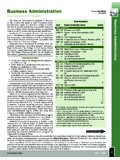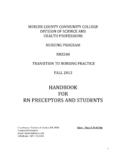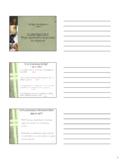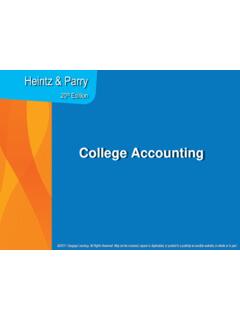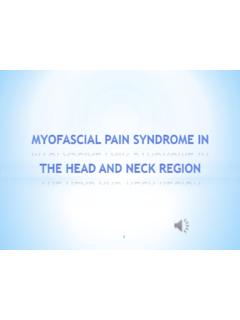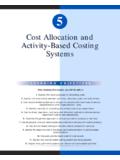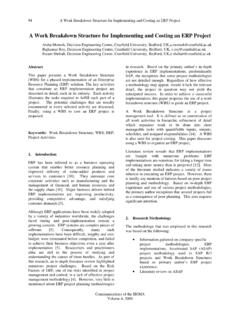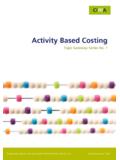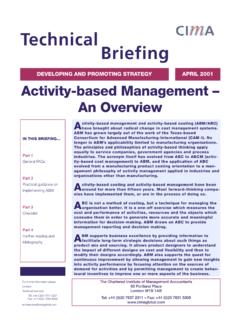Transcription of Chapter 4-1
1 Chapter 4-1 Chapter 4-2 activity - based CostingManagerial AccountingFifth EditionWeygandt Kimmel KiesoChapter 4-3study the difference between traditional costing and activity - based the steps in the development of an activity - based costing how companies identify the activity cost pools used in activity - based how companies identify and use cost drivers in activity - based the benefits and limitations of activity - based between value-added and non value-added the value of using activity levels in activity - based costing . activity - based costing to service 4-4preview of Chapter 4 Chapter 4-5 Managerial Accounting BasicsManagerial accounting, also called management accounting, is a field of accounting that provides economic and financial information for managers and other internal accounting applies to all types of businesses.
2 Corporations Proprietorships Partnerships Not-for-profitChapter 4-6 Allocates overhead using a single predetermined rate. Job order costing : direct labor cost is assumed to be the relevant activity base. Process costing : machine hours is the relevant activity was satisfactory when direct labor was a major portion of total manufacturing costs. Wide acceptance of a high correlation between direct labor and overhead costing and activity - based CostingTraditional costing SystemsSO1 Recognize the difference between traditional costing and activity - based 4-7 Traditional costing and activity - based CostingThe Need for a New ApproachTremendous change in manufacturing and service in amount of direct labor increase in total overhead to use plant-wide predetermined overhead rates when a lack of correlation manufacturing processes may require multiple allocation bases; this approach is called activity - based costing (ABC).
3 SO1 Recognize the difference between traditional costing and activity - based 4-1 Traditional one-stagecosting systemChapter 4-8 Traditional costing and activity - based CostingActivity- based CostingSO1 Recognize the difference between traditional costing and activity - based overhead to multiple activity cost pools, and Assigns the activity cost pools to products or services by means of cost 4-9 Traditional costing and activity - based CostingActivity- based CostingSO1 Recognize the difference between traditional costing and activity - based :any event, action, transaction, or work sequence that incurs cost when producing a product or providing a Cost Pool:the overhead cost attributed to a distinct type of activity For example: ordering materials or setting up machinesCost Drivers:any factor or activity that have a direct cause-effect relationship with the resources 4-10 Traditional costing and activity - based CostingActivity- based CostingSO1 Recognize the difference between traditional costing and activity - based allocates overhead costs in two stages:Stage 1:Overhead costs are allocated to activity cost 2.
4 The overhead costs allocated to the cost pools is assigned to products using cost more complex a product s manufacturing operation, the more activities and cost drivers likely to be 4-11 Traditional costing and activity - based CostingActivity- based CostingSO1 Recognize the difference between traditional costing and activity - based 4-2 Activities and related cost driversChapter 4-12 Traditional costing and activity - based CostingActivity- based CostingSO1 Recognize the difference between traditional costing and activity - based 4-3 ABC system design Lift Jack CompanyChapter 4-13 Indicate whether the following statements are trueor traditional costing system allocates overhead by means of multiple overhead
5 costing allocates overhead costs in a two-stage material and direct labor costs are easier to trace to products than on notes pageTraditional costing and activity - based CostingSO1 Recognize the difference between traditional costing and activity - based 4-14 Indicate whether the following statements are trueor manufacturing processes have become more automated, more companies have chosen to allocate overhead on the basis of direct labor activity - based costing , an activity is any event, action, transaction, or work sequence that incurs cost when producing a costing and activity - based CostingSO1 Recognize the difference between traditional costing and activity - based on notes pageChapter 4-15 Example of ABC Versus Traditional CostingSO2 Identify the steps in the development of an activity - based costing allocates overhead costs in two stages:Stage 1:Overhead costs are allocated to activity cost 2.
6 The overhead costs allocated to the cost pools is assigned to products using cost more complex a product s manufacturing operation, the more activities and cost drivers likely to be 4-16 Atlas Company produces two automobile antitheft devices: The Boot: a high volume item with sales totaling 25,000 per year The Club:a low volume item with sales totaling 5,000 per yearEach product requires 1 hour of direct labor Total annual direct labor hours (DLH) 30,000 (25,000 + 5000) Direct labor cost $12 per unit for each productExpected annual manufacturing overhead costs $900,000 Direct materials cost: The Boot -$40 per unit The Club -$30 per unitExample of ABC Versus Traditional CostingSO2 Identify the steps in the development of an activity - based costing :Required.
7 Calculateunitcosts under 4-17 ProductsManufacturing costsThe BootThe ClubDirect materials$40$30 Direct labor1212 Overhead30*30*Total unit cost$82$72* Overhead rate = $900,000/30,000 DLH = $30 per DLH Overhead = ($30 X 1 hr. = $30)Example of ABC Versus Traditional CostingSO2 Identify the steps in the development of an activity - based costing : Chapter 4-18 Example of ABC Versus Traditional CostingActivity- based costinginvolves the following four and classify the major activities and allocate manufacturing overhead costs to the appropriate cost the cost driver that has a strong correlation to the costs in the cost the overhead rate for each overhead costs for each costs to products using the overhead Know how companies identify the activity cost pools used in activity - based 4-19 Identify and Classify Activities and AllocateOverhead to Cost Pools (Step 1)
8 Example of ABC Versus Traditional CostingSO3 Know how companies identify the activity cost pools used in activity - based 4-4 Overhead costs are assigned directly to the appropriate activity cost 4-20 Identify Cost Drivers (Step 2)The cost driver must accurately measure the actual consumption of the activity by the various of ABC Versus Traditional CostingSO4 Know how companies identify and use cost drivers in activity - based 4-5 Chapter 4-21 Compute Overhead Rates (Step 3)Next, the company computes an activity - based overhead rateper cost of ABC Versus Traditional CostingSO4 Know how companies identify and use cost drivers in activity - based 4-6 Illustration 4-7 Chapter 4-22 Assign Overhead Cost to Products (Step 4)In assigning overhead costs, it is necessary to know the expected use of cost drivers for each product.
9 Because of its low volume, The Club requires more set-ups and inspections than The of ABC Versus Traditional CostingSO4 Know how companies identify and use cost drivers in activity - based 4-8 Chapter 4-23 Assign Overhead Cost to Products (Step 4)To assign overhead costs, Atlas multiplies the activity - based overhead rates per cost driver (Ill. 4-7) by the number of cost drivers expected to be used per product (Ill. 4-8).Example of ABC Versus Traditional CostingSO4 Know how companies identify and use cost drivers in activity - based 4-9 Chapter 4-24 Assign Overhead Cost to Products (Step 4)To assign overhead costs, Atlas multiplies the activity - based overhead rates per cost driver (Ill.)
10 4-7) by the number of cost drivers expected to be used per product (Ill. 4-8).Example of ABC Versus Traditional CostingSO4 Know how companies identify and use cost drivers in activity - based 4-9 Chapter 4-25A likely consequence of the differences in assigning overhead isthat Atlas has been overpricing The Bootand possibly losing market share to competitors. It also has been sacrificing profitabilityby underpricing The of ABC Versus Traditional CostingSO4 Know how companies identify and use cost drivers in activity - based 4-10 Comparing Unit CostsChapter 4-26 Comparing Unit CostsUnder ABC, overhead costs are shifted from the high volume product (The Boot) to the low volume product (The Club) because.
